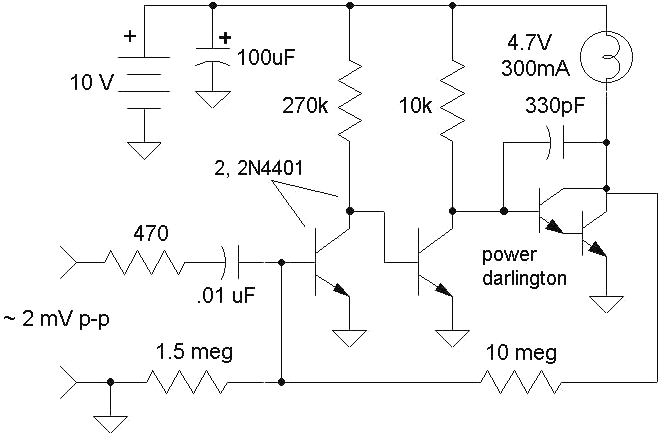Audio Amplifiers modulated light
The input impedance is about 5000 ohms and the frequency response is flat from 30 Hz to over 20,000 Hz. With the 8 ohm speaker the current drain is about 215 mA and the gain is about 1700 (64 dB). With the 16 ohm speaker the current gain is about 110 mA and the gain is about 2500 (68 dB). A volume control may be added by connecting one end of a 5k potentiometer to ground, the wiper to the amplifier input. The other end of the pot becomes the input.
Lets face it; just about any of the various IC audio amplifiers make more sense than this inefficient design. But, this circuit uses parts with only 3 legs. Umm, it doesn't use large capacitors except for the power supply bypassing. Lets see, its more fun-ariffic. Well, lets see if we can come up with a project that takes advantage of the inefficiency
It is a modulated light sender! Connect the input to an audio source or microphone (a speaker will work) and the audio will amplitude modulate the light intensity. The inefficiency of the class-A works in our favor now, lighting the lamp to mid-brightness with no audio present. Actually, with a 4.7 volt bulb, the lamp will be near full brightness and will be "overdriven" on sound peaks. A higher voltage bulb will last longer but will be dimmer. Try a 6.8 volt bulb as a compromise. With a sensitive detector like a phototransistor, this communicator will work several hundred feet (at night). Best range is realized if the bulb is mounted in a typical flashlight reflector and the detector is similarly mounted. The input capacitor is reduced to .01 uF to give the amplifier a high-pass character to compensate for the slow response of the bulb. The audio will sound a bit muffled, anyway. The clever designer could use this amplifier for the receiver, too, switching the speaker to the input for transmitting and to the output for listening. If you choose a detector with good infrared response, like a pin photo diode, you can add plastic IR filters to block out ambient light and make the communicator harder to see at night.
Increasing the voltage to 12 VDC, replacing the bulb with a 3 watt, 16 ohm speaker and replacing the .01uF with a 1uF gives an audio amp that will deliver nearly 1 watt of audio power. The speaker will get warm, however! (Due to the nearly 2 watts of DC power in the speaker coil.)
The input impedance is about 5000 ohms and the frequency response is flat from 30 Hz to over 20,000 Hz. With the 8 ohm speaker the current drain is about 215 mA and the gain is about 1700 (64 dB). With the 16 ohm speaker the current gain is about 110 mA and the gain is about 2500 (68 dB). A volume control may be added by connecting one end of a 5k potentiometer to ground, the wiper to the amplifier input. The other end of the pot becomes the input.
Lets face it; just about any of the various IC audio amplifiers make more sense than this inefficient design. But, this circuit uses parts with only 3 legs. Umm, it doesn't use large capacitors except for the power supply bypassing. Lets see, its more fun-ariffic. Well, lets see if we can come up with a project that takes advantage of the inefficiency
It is a modulated light sender! Connect the input to an audio source or microphone (a speaker will work) and the audio will amplitude modulate the light intensity. The inefficiency of the class-A works in our favor now, lighting the lamp to mid-brightness with no audio present. Actually, with a 4.7 volt bulb, the lamp will be near full brightness and will be "overdriven" on sound peaks. A higher voltage bulb will last longer but will be dimmer. Try a 6.8 volt bulb as a compromise. With a sensitive detector like a phototransistor, this communicator will work several hundred feet (at night). Best range is realized if the bulb is mounted in a typical flashlight reflector and the detector is similarly mounted. The input capacitor is reduced to .01 uF to give the amplifier a high-pass character to compensate for the slow response of the bulb. The audio will sound a bit muffled, anyway. The clever designer could use this amplifier for the receiver, too, switching the speaker to the input for transmitting and to the output for listening. If you choose a detector with good infrared response, like a pin photo diode, you can add plastic IR filters to block out ambient light and make the communicator harder to see at night.
Increasing the voltage to 12 VDC, replacing the bulb with a 3 watt, 16 ohm speaker and replacing the .01uF with a 1uF gives an audio amp that will deliver nearly 1 watt of audio power. The speaker will get warm, however! (Due to the nearly 2 watts of DC power in the speaker coil.)





